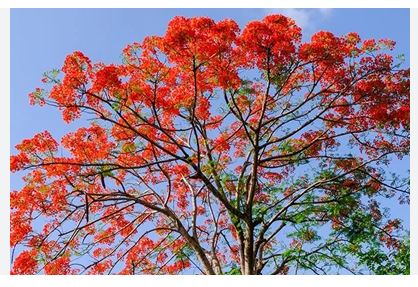
Trees with red flowers are celebrated for their bold, vibrant blooms that create striking focal points in landscapes. These deciduous, evergreen, or semi-evergreen trees vary from small to large, offering diverse forms that suit gardens, streets, or tropical settings. Their vivid red blossoms, appearing in spring, summer, or year-round in warm climates, add dramatic color and elevate aesthetic appeal.
The flowers, ranging from trumpet-shaped to clustered panicles, attract pollinators like hummingbirds, bees, and butterflies, enhancing biodiversity. Some trees bloom before or alongside emerging foliage, creating a fiery contrast against green or bronze leaves. Others feature ornamental bark, fruit, or foliage, providing multi-seasonal interest beyond their floral display.
These trees thrive in a range of climates, typically preferring full sun to maximize flowering. Well-drained soil, whether sandy, loamy, or slightly acidic, supports healthy growth, and many are drought-tolerant once established. Some adapt to coastal or arid conditions, while others require moist environments, offering versatility for various garden styles.
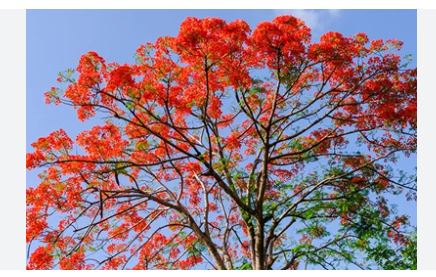
Used as shade providers, privacy screens, or specimen plants, these trees enhance both urban and rural landscapes. Their low-maintenance nature and ecological benefits make them ideal for sustainable designs. Some produce edible fruit or have cultural uses, though certain species may have toxic parts, requiring careful placement.
Selecting trees with red flowers involves matching their size, bloom season, and climate needs to your garden’s conditions. Proper care, including pruning after flowering and monitoring for pests, ensures long-lasting beauty. With thoughtful planning, these trees deliver vibrant, pollinator-friendly displays that enrich any outdoor space.
- African Tulip Tree (Spathodea campanulata)
- Hong Kong orchid Tree (Bauhinia blakeana)
- Peacock Flower Tree (Caesalpinia pulcherrima)
- Flamboyant Tree (Delonix regia)
- Red Flowering Gum (Corymbia ficifolia)
- Bottle Brush Tree (Callistemon)
- Prairifire Flowering Crabapple (Malus Prairifire)
- Pomegranate Tree (Punica granatum)
- Indian Coral Tree (Erythrina variegata)
- Flame of the Forest Tree (Butea monosperma)
- Red Rocket Crape Myrtle
- October Glory Maple Tree (‘October Glory’ Acer rubrum)
- Red Rose of Sharon (Althea Tree)
- Royal Purple Smoke Tree (Cotinus coggygria)
- Red Silk Cotton Tree (Bombax ceiba)
- Southern Silky Oak (Grevillea robusta)
- Red Frangipani Tree (Plumeria rubra)
- Oleander (Nerium oleander)
African Tulip Tree
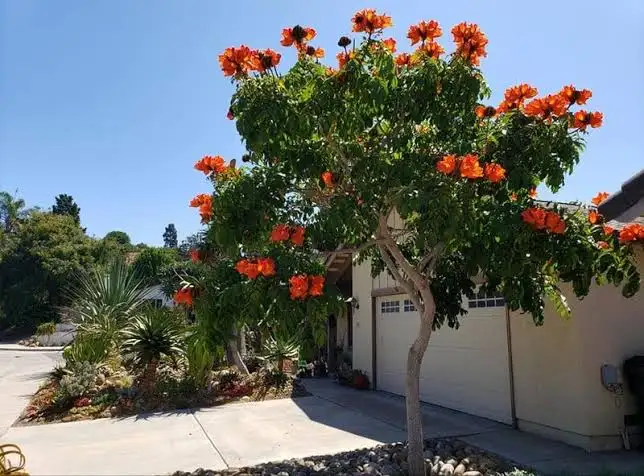
African tuliptree reaches 80 feet tall under ideal growing conditions. The leaves reach 12 to 24 inches long, presenting a bronze color when first emerging at the branch ends. Large red-orange tulip-like flowers appear during the spring and occasionally through summer.
When exposed to freezing temperatures, the tuliptree drops its leaves, which grow back in the spring. African tulip tree tends to be invasive in tropical climates, such as Hawaii and southern Florida, where it forms dense thickets that interfere with native growth.
Hong Kong orchid tree
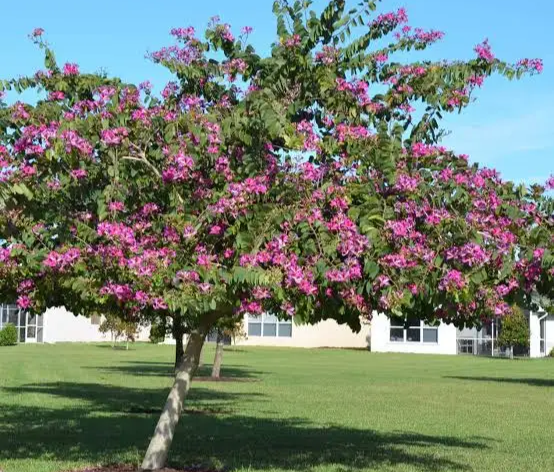
The tree was first discovered by French missionaries on the western coast of Hong Kong and is the official tree of the island. These beautiful tropical trees are often referred to as evergreens, but in truth they’re deciduous and drop their leaves in late winter before forming spring buds. Hong Kong orchid tree reaches 20 feet tall and 25 feet wide with deep rose-red orchid-like flowers and heart-shaped, thick leaves 5 to 8 inches wide.
Also Read: Trees With Pink Flowers For Landscaping Your Yard
Peacock Flower Tree
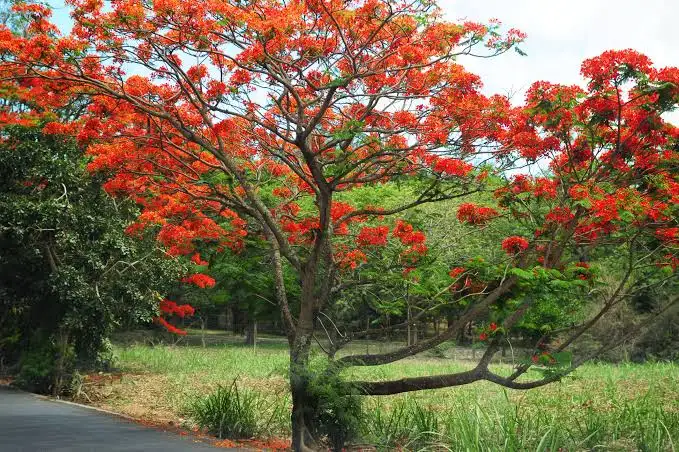
The peacock flower tree, also called Barbados pride or red bird-of-paradise tree, is native to the West Indies. It reaches a height of 15 to 20 feet at maturity and has a very wide, spreading growth habit. Its stems and branches have sharp spines, and its lacy leaves are made up of many small oval leaflets.
Its blossoms are quite showy, with five crinkled red and orange petals surrounding 10 long, bright-red stamens that extend well beyond the petals. The tree blooms in late summer and fall, then produces flat, 3-inch-long pods that split open and drop brown beans.
Flamboyant Tree
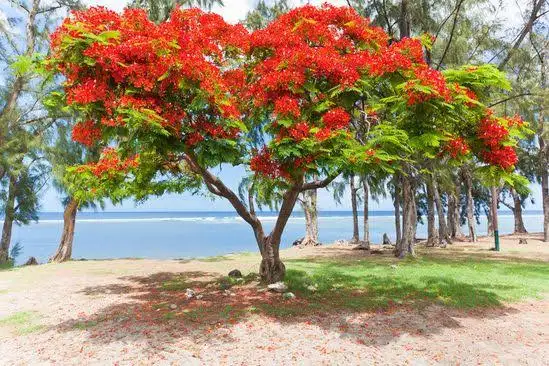
Delonix regia, known as flamboyant, flame tree or Royal poinciana is a majestic tree which can reach a height of more than fifteen metres, the trunk is always rather low, with long enlarged branches which tend to grow horizontally giving the plant its characteristic umbrella shape, covered by bipinnate leaves which resemble those of the fern.
This tree is renowned worldwide for its clusters of exquisite red flowers that blanket the tree in the warm summer months. Each of the five petals is reddish-orange or scarlet. One petal is bigger than the others and has yellow and white markings.
Red Flowering Gum

Corymbia ficifolia (Red Flowering Gum) is a moderately fast growing evergreen tree boasting a profusion of bright flower clusters in summer, and sporadically throughout the year. The flowers are generally conspicuously red or vermillion-orange (rarely pink).
This flowering gum grows up to 12 metres with rough non-shedding bark and usually a rounded and dense crown, making it an excellent shade tree. Its oval leaves are distinctive as they are dark green on top and paler green on their undersides.
Bottlebrush Tree
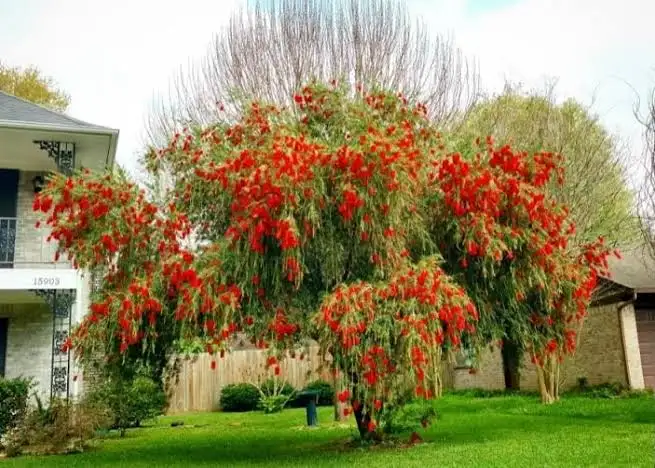
An evergreen tree or shrub native to Australia, the bottlebrush is well known for its graceful, drooping branches ending in flowers with cheerful, bright red or yellow stamens, which form in tufted clusters that resemble a round brush.
Although most bottlebrush are about 5 to 12 feet tall, some mature trees can reach more than 30 feet in height. In addition, the leaves contain essential oils that have a pleasant lemony scent when the leaves are rubbed between the fingers.
Also Read: Popular Flowering Trees For Your Home Garden
Prairifire Flowering Crabapple

Prairifire tree is a member of fruiting trees that produce copious blooms and edible fruit. It can grow 20 feet tall with a spread of 15 feet. It has a nicely compact form, gently rounded with light gray, scaly bark.
The flowers are very fragrant, deeply pink and considered showy when they appear in spring. The Prairifire Crabapple is showy all year long. Plant several along your driveway and create a grand entrance for your guests, no matter what time of year they arrive.
Pomegranate Tree

The pomegranate can range from a dwarf shrub of 3 feet to a tree of 20 to 30 feet. The average size of a standard pomegranate shrub is 12 to 16 feet tall with a round shape. In most places, they are deciduous, but in warmer climates, they may be evergreen.
They are also attractive ornamentally, with glossy leaves and scarlet red, tube-shaped flowers that are attractive to hummingbirds and other pollinators. The pomegranate is a popular choice for bonsai. The bark is a red-brown color, and branches may have spines.
Indian Coral Tree

Indian coral tree (Erythrina variegata) is a tropical and sub-tropical shade tree often planted singly in wide-open landscaping areas. It may be spiny or smooth, deciduous or evergreen, with a spectacle of a flower in brilliant pink, red, or orange hues. It flowers in spring, and its seedpods are poisonous.
The average height of a coral tree is 35 to 45 feet tall, but some varieties exceed 60 feet in height. The trees have a thick trunk, usually with several smaller trunks joining the main stem. Roots push out of the ground as they age and may become a hazard. The bark is a thin grayish brown, and the wood is pithy and weak, prone to breaking in the wind or due to overwatering.
Flame of the Forest
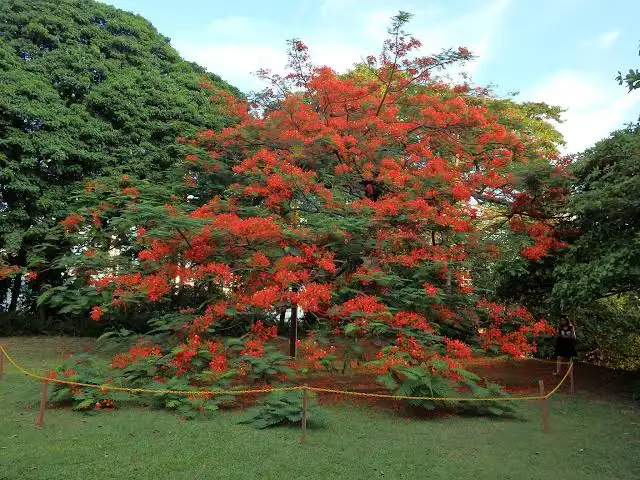
Flame of the Forest is a small to medium-sized deciduous tree growing from 20 to 4O feet high, and the trunk is usually crooked and twisted with irregular branches and rough, grey bark. The tree has a rounded canopy of leathery, dark green, compound trifoliate leaves.
From late winter to early spring, it is covered with a profusion of brilliant red-orange flowers, borne in large clusters near the tips of the branches, the blossoms give way to flat single-seeded pods that mature to bronze-brown. Worshipped as sacred by the Hindus, it is widely cultivated in southern Asia.
Also Read: Trees With Red Leaves To Add Color And Seasonal Interest To Your Yard
Red Rocket Crape Myrtle Tree
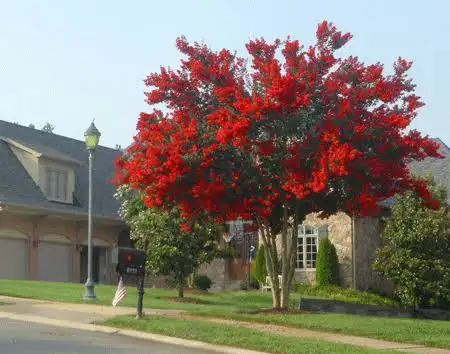
Just like its name suggests, the Red Rocket Crape Myrtle Tree shoots up like a rocket, growing up to 5 feet or more in only one year and it is considered one of the fastest-growing crape myrtles. This stunning tree is renowned for its showy flowers, beautiful bark, fast growth, and tolerance of soil conditions.
The red rocket crape myrtle is best for those who want a beautiful plant, as this plant is known for its beautiful striking colors and flower petals resembling crepe paper. This crape myrtle variety can add a mystical visual interest to your landscaping. Moreover, it works well as a standalone plant or even as part of an assorted collection.
October glory maple tree

The October glory maple tree is actually a cultivar of the more common red maple or Acer rubrum. These trees grow well under a variety of conditions, provide spectacular autumn color and bright red, showy fruit. As a hardy, all-purpose tree, it is hard to go wrong with this variety.
Its most distinguishing characteristic, its scarlet red autumn foliage, begins in early October, as the name suggests. The spectacular scarlet coloration persists for weeks, often after many neighboring species have already shed their leaves. Accompanying the striking foliage are clusters of shiny, bright red fruit that attract numerous bird species to your yard – a contrast to the usually drab brown keys most maples produce.
Red Rose of Sharon
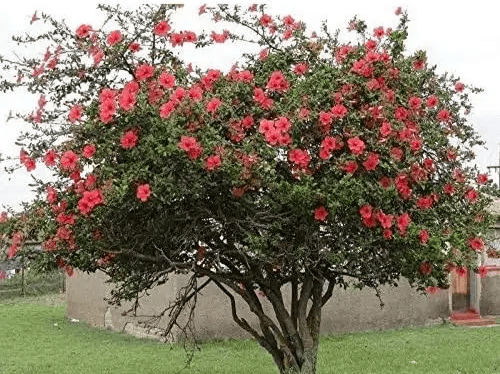
Althea is a deciduous, ornamental shrub more commonly referred to as the Rose of Sharon. From early summer to late fall, this long blooming, vigorous growing shrub is adorned with showy, heavily ruffled, red flowers with a dark crimson throat and protruding, tube-shaped stamens that look particularly stunning when planted in groups or around borders.
It exhibits a slow-to-moderate growth rate, and reaches a height of about 15 feet and a spread of about 12 feet and fits beautifully into any garden, making it a perfect choice where space is limited. You can even plant it in a decorative container for your deck or patio.
Also Read: Different Types of Trees With White Bark
Royal Purple Smoketree
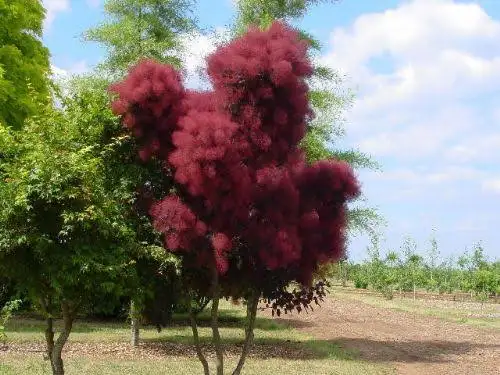
Smoke bush is a deciduous shrub or small tree often used as a garden specimen thanks to its beautiful purple-pink or pink-red smokey plumes and the purple leaves found on some cultivars. This bush thrives in poor, rocky soils, and once established it is drought resistant and hardy.
Smoke bush has an upright, multi-stemmed habit. The leaves are waxy green except for those cultivars with purple leaves. Ovate-shaped leaves grow up to 3 inches long, turning yellow, orange, or purplish-red in fall, depending on the variety. The name “smoke bush” derives from billowy hairs attached to the flower clusters, which remain in place through the summer, turning a smoky red to purplish-pink as the weeks progress.
Red Silk Cotton Tree
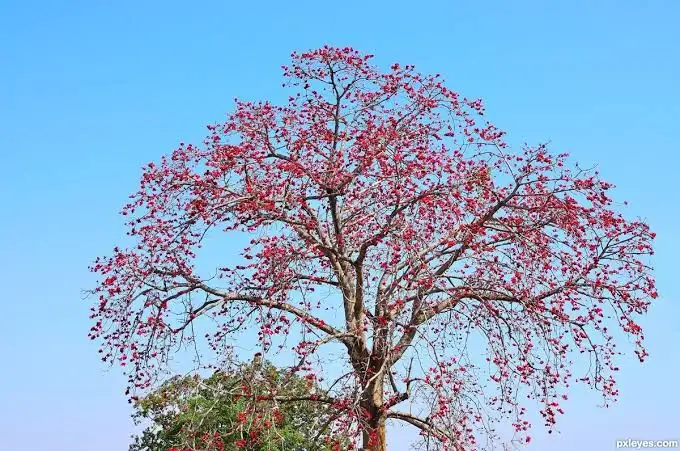
Bombax ceiba, like other trees of the genus Bombax, is commonly known as cotton tree. More specifically, it is sometimes known as Malabar silk-cotton tree grows to an average of 20 meters, with old trees up to 60 meters in wet tropical regions.
This Asian tropical tree has a straight tall trunk and its leaves are deciduous in winter. Red flowers with 5 petals appear in the spring before the new foliage. It produces a capsule which, when ripe, contains white fibres like cotton. Its trunk bears spikes to deter attacks by animals. Although its stout trunk suggests that it is useful for timber, its wood is too soft to be very useful.
Red Silky Oak
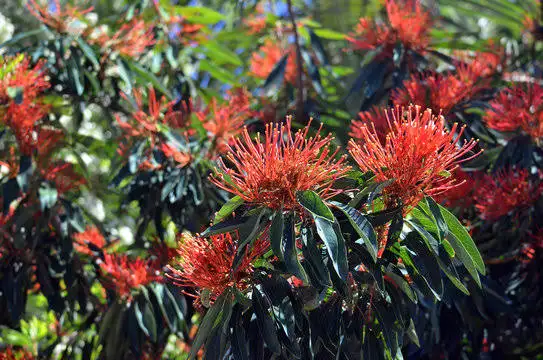
Silk Oaks are majestically handsome trees succeeding and flower in temperate or tropical climates. The particular species is a fast growth rate evergreen tree reaching up to incredible heights between 20’ – 100’ feet. The trunk is straight, and unbuttressed, and is 31” – 47” inch in diameter.
The flowers are glabrous and mostly yellowish orange, or sometimes reddish. Flowering occurs from September to November and the fruit that follows is a glabrous follicle. When young, it can be grown as a houseplant where it can tolerate light shade, but it prefers full sun because it grows best in warm zones.
Also Read: Different Types of Crape Myrtle Trees For Growing At Home
Red Frangipani Tree
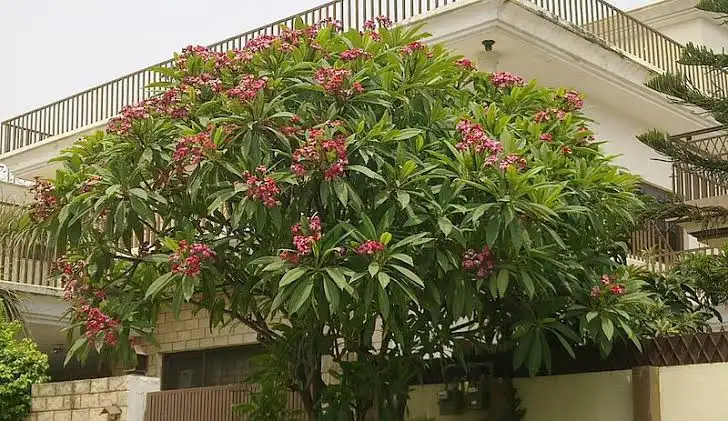
Plumeria rubra (Red Frangipani) is a deciduous shrub or small tree of vase or umbrella shape with fleshy, succulent branches boasting highly fragrant, spiral-shaped, yellow-centered pink to red flowers. Blooming throughout most of the year in tropical areas, the blossoms are borne in terminal clusters at the branch tips. Leathery, narrowly elliptic, dark green leaves are spirally arranged and clustered at the stem ends.
In areas where temperatures drop below 50ºF (10ºC) during winter, the crown will lose its leaves for a short time displaying the coarse-textured, stubby branches. Frangipani works well as a freestanding specimen, a patio tree, or as part of a mid shrub border. The wonderfully scented flowers are often made into leis or worn in the hair.
Oleander
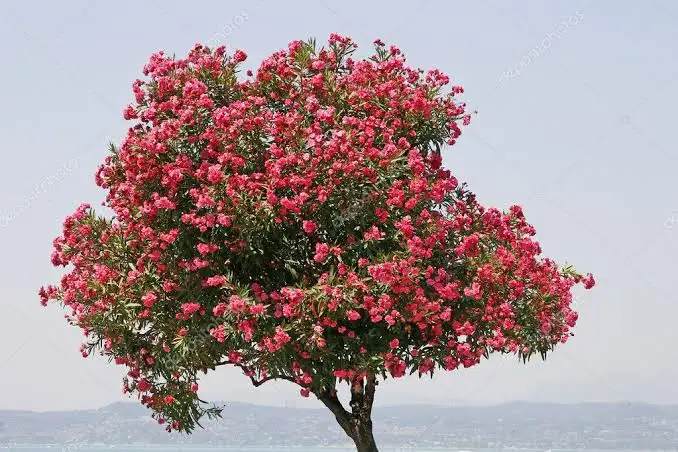
Nerium oleander, most commonly known as oleander or nerium, is a shrub or small tree cultivated worldwide in temperate and subtropical areas as an ornamental and landscaping plant. Delicately shaped, showy, fragrant flowers tend to be pink, while some varieties produce red, orange or yellow flowers.
Oleander grows naturally as a mounded, round shrub, or it can be trained as a small single- or multi-trunked tree. The evergreen foliage is dense, leathery, and dark green, offering a privacy screen when planted in groups or borders. Blooming for an especially long period, the one- to three-inch flowers appear from spring to summer and sometimes early fall and year-round in warmer climates.
Red Flowering Dogwood (Cornus florida ‘Cherokee Chief’)
This small deciduous tree, growing 20–25 feet, produces vibrant red flower bracts in spring. Hardy in Zones 5–9, it thrives in full to partial shade and acidic, well-drained soil. Its scarlet fall foliage and alligator-like bark add year-round interest, making it ideal for small gardens or woodland borders.
Red Buckeye (Aesculus pavia)
A small tree or shrub, reaching 10–20 feet, it bears cone-shaped clusters of bright red flowers in spring. Native to the southeastern U.S., it’s hardy in Zones 4–8 and prefers full sun to partial shade. Its palmate leaves and hummingbird-attracting blooms suit mixed borders or wildlife gardens.
Red Horse Chestnut (Aesculus × carnea)
Growing 30–40 feet, this deciduous tree displays pinkish-red flower panicles in late spring. Hardy in Zones 5–8, it thrives in full sun and well-drained soil. Its large leaves and low-maintenance nature make it a striking shade tree for parks or large yards.
Firewheel Tree (Stenocarpus sinuatus)
This Australian native, growing 30–50 feet, features wheel-like red flower clusters in spring. Hardy in Zones 9–11, it prefers full sun and well-drained soil. Its glossy, fern-like leaves and tropical appeal make it perfect for coastal or ornamental gardens.
Flame Tree (Brachychiton acerifolius)
A deciduous Australian tree, reaching 30–50 feet, it produces scarlet bell-shaped flowers in spring before leaves emerge. Hardy in Zones 9–11, it thrives in full sun. Its maple-like leaves and bird-attracting blooms suit large gardens or streetscapes.
Cockspur Coral Tree (Erythrina crista-galli)
This South American tree, growing 15–20 feet, bears vivid red flower spikes in summer. Hardy in Zones 7–10, it prefers full sun and moist, well-drained soil. Its bold blooms and compact size make it ideal for tropical gardens or containers.
Common Coral Tree (Erythrina lysistemon)
Growing 20–30 feet, this South African deciduous tree produces bright red flower clusters in late winter to spring. Hardy in Zones 9–11, it thrives in full sun and well-drained soil. Its pollinator-friendly blooms suit ornamental or shade plantings.
Red Orchid Tree (Bauhinia galpinii)
A small tree or shrub, reaching 10–20 feet, it displays red-orange orchid-like flowers in summer. Native to South Africa, it’s hardy in Zones 9–11 and prefers full sun. Its heart-shaped leaves and drought tolerance make it ideal for xeriscape gardens.
Chinese Hibiscus Tree (Hibiscus rosa-sinensis)
This tropical tree or shrub, growing 8–15 feet, produces large, trumpet-shaped red flowers year-round in warm climates. Hardy in Zones 9–11, it thrives in full sun and well-drained soil. Its glossy leaves suit hedges or patio specimens.
Powderpuff Tree (Calliandra haematocephala)
A small evergreen tree, growing 3–6 feet, it features scarlet powderpuff-like flowers in fall and winter. Hardy in Zones 9–11, it prefers full sun and fertile, well-drained soil. Its feathery foliage is perfect for tropical landscapes or containers.
Scarlet Rose Mallow (Hibiscus coccineus)
This herbaceous perennial, often tree-like, grows 6–10 feet with large red flowers in summer. Native to the southeastern U.S., it’s hardy in Zones 6–9 and prefers full sun and moist soil. Its bold blooms suit wetland gardens or borders.
Red Silky Oak (Alloxylon flammeum)
A large evergreen, reaching 30–50 feet, it produces dense red flower clusters in spring. Native to Australia, it’s hardy in Zones 9–11 and tolerates some frost. Its adaptability and pollinator-friendly blooms make it ideal for tropical gardens.
Coral Magic Crape Myrtle (Lagerstroemia ‘Coral Magic’)
This small tree, growing 6–10 feet, bears vibrant red flower clusters in summer. Hardy in Zones 6–9, it thrives in full sun and well-drained soil. Its compact size and low-maintenance nature suit small gardens or hedges.
Black Diamond Best Red Crape Myrtle (Lagerstroemia ‘Best Red’)
Reaching 10–12 feet, this tree produces striking red blooms against black leaves in summer. Hardy in Zones 6–10, it prefers full sun and well-drained soil. Its vivid contrast makes it a standout for privacy screens or accents.
Dynamite Crape Myrtle (Lagerstroemia ‘Dynamite’)
This deciduous tree, growing 15–20 feet, displays true red flower clusters in summer. Hardy in Zones 6–9, it thrives in full sun and tolerates drought. Its colorful foliage and long bloom period suit specimen or border plantings.
Tonto Crape Myrtle (Lagerstroemia ‘Tonto’)
A small tree, reaching 8–10 feet, it bears magenta-red flowers in summer. Hardy in Zones 6–9, it prefers full sun and well-drained soil. Its compact form and reddish-purple fall foliage make it ideal for small yards or containers.
Japanese Flowering Quince (Chaenomeles japonica)
This small, thorny tree or shrub, growing 6–10 feet, produces red flowers in early spring. Hardy in Zones 5–9, it thrives in full sun and well-drained soil. Its early blooms and edible fruit suit mixed borders or bonsai.
Taiwan Cherry (Prunus campanulata)
A small deciduous tree, growing 15–25 feet, it bears deep red to pink flowers in late winter to early spring. Hardy in Zones 7–9, it prefers full sun and well-drained soil. Its early blooms and bird-attracting fruit make it ideal for small gardens or streets